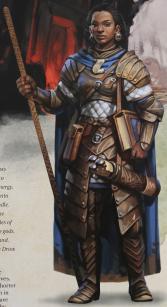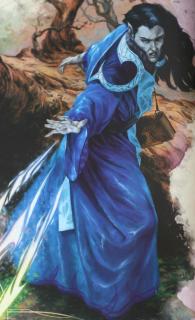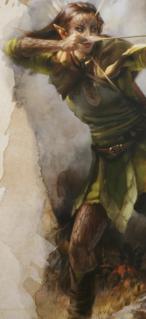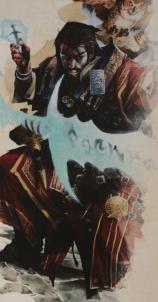As I was paging through the new (5th edition) D&D Player’s Handbook, the art seemed remarkably diverse compared to previous editions.1 Inspired2 by an analysis several years back of Dragon magazine covers, I went through the artwork depicting potential player characters and coded each character, to see if I could learn anything about how diverse and representative they were.
(Before I go any further: If you think I’m missing an important point, or being insensitive in some fashion, please get in touch with me, privately via email or publicly on Twitter, my main account or my tabletop gaming–focused account.)
(Update, Dec. 1, 2014: I wrote a similar piece about the Monster Manual.)
(Update, Sept. 14, 2015: Anna Kreider has done a similar, and better, analysis, Representation in D&D 5E Core Books: “better than the rest” unfortunately still falls short, with a somewhat less positive overall view. Her followups go far beyond this: Numbers Aren’t the Whole Story and Smurfettes and Sexy Corpses focus on the ways in which the art is highly problematic, in ways I either didn’t see or didn’t emphasize. I strongly recommend reading them.)
Methodology
Here are the ways I coded each character in the artwork. (Five characters and how I coded them follow.)
- By D&D race. I did not attempt to draw distinctions between elves and half-elves, unless it was blindingly obvious from the context.
- By D&D class. I generally stuck to the traditional four classes (cleric, fighter, rogue, wizard), except for a few bards or where it was obvious from the context. A sub-coding of this was whether the figure was martial or non-martial. Barbarians, fighters, monks, paladins, and rangers were coded martial; the remainder were non-martial.
- By sex, or more properly, secondary sexual characteristics. I did my best to not assume, for example, that a heavily-armored figure with its back to me was necessarily male; I instead coded that as unknown.
- By skin color. Roughly, I categorized any skin color that looked like it could have come from northern and central Europe as “light”, and any other halfway-plausible real-world human skin color as “dark”. There were many cases where this was surprisingly difficult to judge; often, this was due to the pose or the artwork’s lighting, but sometimes was due to fantastic colors (e.g. a blue tint). A handful of portraits I put in another category, “color”, where the skin color was so far from plausible human colors that it was outside the spectrum (e.g. bright yellow).
- By stance, which I put in one of three categories (below). This is fairly
subjective.
- Active, meaning the character is doing a thing. That thing may or may not be fighting; it could be casting a spell, or playing a lute, or inspecting runes.
- Posed, meaning the character is not doing a thing, but is posed to show what he or she can do.
- Passive, meaning neither of the above. In addition, a character that might be active or posed but is a clear victim is coded as passive instead.
- By the amount of skin showing: none, a little, some, or too much3. The rough guideline I used was whether the amount of skin showing was appropriate for a dungeon delve. This, too, is certainly subjective.
For all codings, I indicated where I guessed at a particular coding but was uncertain (indicated as “uncertain” below). There were some where I simply could not identify one or more aspects of the character given the pose, lighting, etc. (generally skin color or sex); these I coded as “unclear”. (For purposes of the following analysis, however, I’m treating uncertain codings as if they were certain.)4
Below are five images, along with how I coded them. All images are copyright (c) 2014 Wizards of the Coast LLC, reproduction of which I believe to be fair use as criticism or comment.
The first image (left) is from p. 18, representing the dwarf race. I coded this character as being a female dwarf fighter, posed; she has light skin, with none (for our purposes) showing.
The second image (right) is from p. 29, representing the human race. I coded this character as being a female human cleric (the class is uncertain), posed; she has dark skin, with none showing.
Though the two above characters are not active, neither are they passive. They both present appealing role-models, which I think is really what the stance category boils down to (“do I want to be this person?”).
The third image (left) is from p. 200, at the start of the spellcasting chapter. I coded this character as being a female elf wizard, active, though I was uncertain of the sex. She has light skin, with none showing. Here again I was uncertain as to how to categorize her skin color, at least in part due to the unnatural (by real-world standards) tone. I could imagine a reasonable person categorizing this character as a male with dark skin.
The fourth image (right) is from p. 217, near the barkskin spell. I coded this character as being a female elf fighter, active; she has light skin, with a little showing. Note that her skin color is somewhat obscured by what I would guess to be the effects of barkskin, but not enough for me to be uncertain.
The final image (left) is from p. 262, near the Mordenkainen’s sword spell. I coded this character as being a male human wizard, active; he has dark skin (uncertain), with none showing. Note here how the lighting somewhat obscures his skin color: I think a reasonable person could argue that this is a light-skinned character whose skin shows darker in spots due to shadow, though I decided the reverse due to the overall effect of a dark visage.
My per-character coding is available as a CSV file, including some notes, so you can check my work and perhaps do your own analysis with your revisions and/or extensions to my coding.
Basic analysis
Skin color
I counted 82 figures with “light” skin (as well as 4 uncertain), and 25 figures with “dark” skin (as well as 2 uncertain), respectively 67% and 22% of the total count. The remainder were unclear or off the spectrum.
| light 67% (86) |
11% |
dark 22% (27) |
Sex
I counted 55 male figures (and 15 uncertain), 55%, and 39 female figures (and 5 uncertain), 34%. The remainder were unclear.
| male 55% (70) |
11% |
female 34% (44) |
Stance
I counted 67 active figures (52% of the total), 40 posed figures (31%), and 21 passive figures (16%).
| active 52% (67) |
posed 31% (40) |
passive 16% (21) |
Amount of skin
I counted 118 figures (93%) showing no skin, or rather just a small amount appropriate for dungeon delving. Six showed a little, two showed some, and one showed what I considered to be too much, represented in the chart below as the unlabeled sections from left to right (yellow, green, and blue).
| no skin 93% (118) |
Martiality
Martial and non-martial figures (which I’m referring to as “martiality”) were about equally represented: 50 (46%) vs. 59 (54%). Note that I coded five of the 12 classes as martial, which is 42%, pretty close to the actual representation.
| martial 46% (50) |
non-martial 54% (59) |
Correlations
Skin color vs. stance
Stance frequency was identical for light skin (53%/29%/17%) and dark skin (52%/33%/15%).
| light/act 53% (46) |
light/pos 29% (25) |
light/pas 17% (15) |
| dark/act 52% (14) |
dark/pos 33% (9) |
dark/pas 15% (4) |
Sex vs. stance
Males were less likely to be active (32, 46% of males, vs. 26, 59% of females), and more likely to be passive (14, 20% of males, vs. 4, 9% of females). Males and females were shown posed at the same frequency (24 males, 34%, vs. 14 females, 32%).
| male/act 46% (32) |
male/pos 34% (24) |
male/pas 20% (14) |
| fem/act 59% (26) |
fem/pos 32% (14) |
f/pas 9% (4) |
Note that though a higher percentage of females were active, there was still a lower absolute number. (On the other hand, the number of passive females was quite low.)
| m/act 28% (32) |
f/act 23% (26) |
m/pos 21% (24) |
f/pos 12% |
m/pas 12% |
f/pas 4% |
Sex. vs. amount of skin
Of the male figures, 4% (3) showed “a little” or “some” skin (unlabeled sections in the first chart below, left to right (yellow and green)); the most was a bare-torsoed fighter, leaping down onto a fire giant. Of the female figures, 9% (4) showed a little skin, 5% (2) some, and 2% (1) too much (unlabeled sections in the second chart below, left to right (yellow, green, and blue)); the most was a scantily-clad druid with her leopard companion.
| male/no skin 96% (67) |
| female/no skin 84% (37) |
9% (4) |
Another way of thinking about this: There were more than half again as many male figures as female (70 vs. 44), but less than half were showing any skin (3 vs. 7).
| m/a little 20% |
m/some 10% |
f/a little 40% |
f/some 20% |
f/much 10% |
Stance vs. amount of skin
Figures showing any skin were more likely than the total population (70%, vs. 52% of the general population) to be active, and the same likelihood (30%, vs. 31% of the general population) of being posed; none were passive.
Sex vs. martiality
Males were evenly split between martial and non-martial classes. Of the females, however, 15 were martial classes while 23 were non-martial.
| male/martial 50% (31) |
male/non-martial 50% (31) |
| female/martial 39% (15) |
female/non-martial 61% (23) |
Another way of looking at this: there are half as many female martial figures as there are male martial figures.
| m/mar. 31% |
f/mar. 15% |
m/non-mar. 31% |
f/non-mar. 23% |
Thoughts and conclusions
I have somewhat mixed feelings about these numbers.
First, I feel pretty strongly (but without any quantitative basis5) that this is the most-diverse cast I’ve seen in a D&D book. That’s a really good thing. A group of kids could page through this book and find a dozen strong, active female characters to make them say “I want to be her!”.
We’re still not perfect, though. If those kids could find a dozen female characters, they could find — strictly from the percentages here — almost 20 males. That’s not really fair to the kids, who learn that more boys play D&D than girls, that it’s more of a boy’s game than a girl’s. Never mind that this has been historically the case; it’s not the message D&D should be sending, and I suspect it’s not the message the 5th edition team wants to send.
This is mitigated somewhat by the females being more active than the males. It’s un-mitigated (yes I just wrote that; don’t judge me) by the females being less likely to be in a martial role. Back to those kids flipping through the book, not only do they learn that this is more of a boy’s game than a girl’s, they also learn that girls shouldn’t really swing a sword — at least, not as much as boys do. Again, this is not the right message.
Looking for a moment at skin color, I confess I’m not sure how to analyze it. As a first approximation, I’ll compare the numbers here — of the skin colors I could categorize, 76% were “light” and 24% were “dark” — with the 2010 U.S. census data, showing 72% “white”. That’s closer than I thought, to be honest. There are certainly other ways to measure this — perhaps the world population of fluent English-speakers?6 — but I’ll leave it at this for now.
Overall, I’m pretty happy with the diversity of characters in this edition of the Player’s Handbook. With some reservations (above), and with the particular exception of the half-naked druid which I was pretty disappointed by, I’m mostly satisfied with the art in this book. I feel confident that the 5th edition team was making a conscious effort towards a goal of representation and equality, and I choose to think of the shortcomings as room for improvement in the next books.
Now if you’ll excuse me, I have a cleric of the Southern Hummingbird to roll up.
I would like to thank Rachael Worthington and William Van Hecke for their comments on an earlier version of this article (though any remaining weaknesses are, of course, mine). As mentioned above, please feel free to contact me via email or my main or gaming Twitter accounts.
-
For context, I’ve owned and played AD&D 1st and 2nd editions, and D&D 3rd (and 3.5) edition. ↩︎
-
A seven-post series by mr_orgue on LiveJournal. The link above goes to a response to the series by Erik Mona, then editor of Dragon; I’ve chosen it because it includes links to each of the seven posts. ↩︎
-
By “too much”, I kind of mean “an amount of skin where, to explain it to my eight- and five-year-old kids, I would need to invoke the phrase ‘male gaze’”. ↩︎
-
There were at least two images where I realized after the fact that they were portraying the same characters. I examined my coding for each, noted that they differed in some ways, and decided to leave them that way: what’s important for this exercise is how I saw each character, not the intent of the artist. ↩︎
-
Performing a similar analysis on previous editions is left as an exercise for the reader. If you do it, let me know and I’ll link it here. ↩︎
-
A friend who reviewed an early draft of this article pointed out that D&D can be found in translation in other countries (Japan in the particular example), so “fluent English-speakers” is probably too narrow a potential audience. However, this doesn’t get me any closer to a satisfying way to evaluate this aspect of the art. ↩︎




